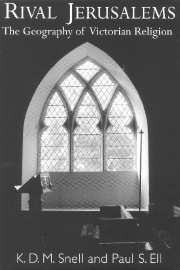Book contents
- Frontmatter
- Contents
- List of figures
- List of tables
- Preface and acknowledgements
- Introduction
- Part 1 Religious geographies: the districts of England and Wales
- 1 The 1851 Census of Religious Worship
- 2 The Church of England
- 3 Old dissent: the Presbyterians, Independents, Baptists, Quakers and Unitarians
- 4 The geographies of new dissent
- 5 Roman Catholicism and Irish immigration
- 6 Denominational co-existence, reciprocity or exclusion?
- Part 2 Religion and locality: parish-level explorations
- Technical appendices
- Bibliography
- Index
3 - Old dissent: the Presbyterians, Independents, Baptists, Quakers and Unitarians
Published online by Cambridge University Press: 08 August 2009
- Frontmatter
- Contents
- List of figures
- List of tables
- Preface and acknowledgements
- Introduction
- Part 1 Religious geographies: the districts of England and Wales
- 1 The 1851 Census of Religious Worship
- 2 The Church of England
- 3 Old dissent: the Presbyterians, Independents, Baptists, Quakers and Unitarians
- 4 The geographies of new dissent
- 5 Roman Catholicism and Irish immigration
- 6 Denominational co-existence, reciprocity or exclusion?
- Part 2 Religion and locality: parish-level explorations
- Technical appendices
- Bibliography
- Index
Summary
This chapter discusses the geography of old dissenting and related denominations, that is the Presbyterian Church in England, the United Presbyterian Church, the Church of Scotland, the Independents (or Congregationalists), the Baptists, the Quakers and the Unitarians. One has reservations about any such grouping which are worth mentioning. ‘Old’ and ‘new’ dissent are terms of historical convenience, like the ‘industrial revolution’ and so many others used by historians. Though categories of this sort are useful in many ways, and have a basic chronological justification, one needs to be aware that many ‘old dissenting’ denominations benefited enormously from the evangelical revival of the eighteenth century, which itself originated within the Anglican Church. This was particularly true for the Congregationalists, the Particular Baptists and the New Connexion General Baptists. Methodist innovations like itinerancy were also shared by some older denominations. There were many contemporaries who commented upon these denominations as a whole, and who would have had some sympathy with Gilbert's view that such denominations were ‘linked in a single, if multiform, social and religious phenomenon’. Denominational spread was affected in a host of ways by affinities, as well as by inter-denominational hostilities; and such affinities underlay similar growth patterns, as well as the comparable or complementary dispersion of denominations shown here.
A more detailed reservation has to do with source coverage. The registration-district tables of the 1851 Religious Census failed to divide Baptists into the Particular Baptists, General or Arminian Baptists, and (from 1770) the General Baptists of the New Connexion.
- Type
- Chapter
- Information
- Rival JerusalemsThe Geography of Victorian Religion, pp. 93 - 120Publisher: Cambridge University PressPrint publication year: 2000

